The kit is equipped with a handy carry bag that is made of durable polyester. On top of that, the total length of the tripod when it's folded is only 46 cm, which allows it to be put pretty much anywhere inside your car.
The ball joint doesn't rotate smoothly.
Despite a relatively low weight of only 1,35 kg, this camera stand can hold exceptionally heavy appliances with a total weight of up to 10 kg without too much of an issue. Moreover, the product also provides excellent stabilisation to your footage and shots as well as a reliable base.
6.35-mm (1/4”) mounting screw
41.5 - 156.5 cm
Aluminium alloy
Multi-angle ball joint, Non-slip feet, Spring hook at the bottom, Carry pouch included
1.35 kg / 10 kg
Amazon's 30-day return policy
The quick-release leg (flip) locks provide decent stabilisation on uneven terrain, while the horseshoe pads on the bottom of the tripod legs make the whole assembly a lot more stable. The height, on the other hand, can be adjusted anywhere in the range of 63-170 cm.
The carry handle is not exactly something you could call ergonomic.
The ESDDI camera tripod has quite a few things that you can adjust, which makes the filming process less of a chore. The configurable height and individual leg length adjustments will also help in picking the best angle to shoot photos and videos at. Perfect for panoramic shots.
6.35-mm (1/4”) mounting screw
Spring-loaded holder for smartphones
63 - 170 cm
Aluminum alloy
Multi-angle ball joint, Non-slip feet, Spring hook at the bottom, Carry pouch included
1.35 kg / 5 kg
6 months
The housing, as well as the leg sections, are made of high-quality aluminium alloy so the tripod is highly unlikely to break down in field conditions. To add more, the multi-angle ball joint allows for turning the camera in any direction without losing the focus of the shot.
The tripod extenders are quite stiff.
This Tacklife camera holder outperforms the majority of competition thanks to its universal spring-loaded phone holder. This subtle feature allows using the tripod with trail cameras, camcorders, monoculars and binoculars alike.
6.35-mm (1/4”) mounting screw
Spring-loaded holder for smartphones
42 - 136 cm
Aluminum alloy
Multi-angle ball joint, Non-slip feet, Carry pouch included
0.59 kg / 3 kg
2 years
The kit is equipped with a special Bluetooth remote-controlled shutter that allows taking shots from up to 10-15 metres away from the connected camera. In addition, the mounting options additionally include a spring-loaded phone holder.
Due to its light weight can be tricky to use outdoors.
EVERESTA TP-2141 will be a good alternative to cheap monopod camera holders by providing better stabilization to your camera or smartphone. With that in mind, this model will be a good pick for bloggers, vloggers, as well as for basic video streaming purposes.
6.35-mm (1/4”) mounting screw
Spring-loaded holder for smartphones
35 - 102 cm
Aluminium alloy
Bluetooth remote control (uses "CR2032" battery), Multi-angle ball joint, Non-slip feet, Carry pouch included
0.42 kg / 2 kg
Amazon's 30-day return policy
The non-slip rubber feet provide an additional level of protection to the telescopic legs of the camera holder. Conversely, the threaded centre column has a weighting hook that can be used to add weight to the whole assembly.
The finish is vulnerable to scratches.
Hama Star 75, despite its seeming flimsiness, will be an excellent pick for semi-professional and entry-level photographers that desperately need a camera holder. It is simple, reliable, and features everything you need to get started.
6.35-mm (1/4”) mounting screw
42.5 - 125 cm
Aluminium alloy
Multi-angle ball joint, Non-slip feet, Spring hook at the bottom, Carry pouch included
0.62 kg / 2.5 kg
2 years
This site is a free online resource that strives to offer helpful content and comparison features to its visitors. Please be advised that the operator of this site accepts advertising compensation from certain companies that appear on the site, and such compensation impacts the location and order in which the companies (and/or their products) are presented, and in some cases may also impact the scoring that is assigned to them. The scoring that appears on this site is determined by the site operator in its sole discretion, and should NOT be relied upon for accuracy purposes. In fact, Company/product listings on this page DO NOT imply endorsement by the site operator. Except as expressly set forth in our Terms of Use, all representations and warranties regarding the information presented on this page are disclaimed. The information which appears on this site is subject to change at any time. More info
K&F Concept TM2324
For Outdoor and Indoor Use
The K&F Concept TM2324 is yet another lightweight tripod stand for DLSR cameras, but this time its weight is even closer to the mark of 1 kg than towards the 2-kg mark and that is not a bad thing at all, simply because that feature makes the stand more portable.
With a total weight of only 1.35 kg, the TM2324 is not the bulkiest tripod from the whole bunch but it surely is durable and easy to carry around. Aside from the main 6.5 mm screw mount, this tripod model also features a special spring-loaded mount that enables fixing phones on it.
The only noticeable drawback of this particular model is its ball joint that can be a little wacky to rotate. However, once you get the hang of how it operates, it won’t be that huge of a problem in the long run. On the bright side, though, owing to the reverse folding leg mechanism, the tripod takes less space than similar products in the same category. With that in mind, this model can be put in any larger bag which ultimately saves space without compromising the functionality of a fully-fledged care stabilizer.
All in all, this model will be an optimal pick for both professional and casual photographers out there, thanks to its simple yet versatile design. Despite the initial roughness around the edges, the K&F Concept TM2324 proves to be an excellent tripod that can be used regularly with ease.
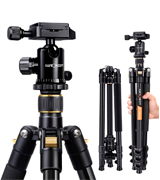
ESDDI TP-35
Aluminium Design At Its Best
The ESDDI TP-35 is also a fairly lightweight product on our list. But does the weight alone make it a decent option? Not exactly.
To start off, the mount fits all 6.35-mm (¼”) based cameras and that makes it almost universally compatible with most modern photo and video appliances. What is more, the packaging also comes with a mobile phone clip, which is spring-loaded for the added security of your mobile gadget.
Specifications-wise the elevation can be adjusted anywhere in the range of 63 to 170 cm above the ground. To make filming a tad bit safer, every leg of the tripod features a horseshoe pad that gives the whole aluminium assembly additional stability. As a nice little bonus, you can also quick-release the flip lock in case the terrain is uneven.
The feature that we didn’t really appreciate about this package, though, is the carry handle that is not really that ergonomic. However, considering that the whole kit weighs just under 1.35 kg, it won’t be that huge of a deal.
Minor quirks aside, let’s take a quick glance what else is included in the kit aside from the actual tripod. For your convenience, the package also features a carry case and a fairly durable strap that helps in keeping things organised. Although the case is a tight fit for a tripod you can still put a few other handles and attachments inside without it being too bulky to carry around.
Wrapping things up, the ESDDI TP-35 is a great mid-range tripod that fits both DSLR and film cameras with ease, as well as phones, which makes it a good compromise between expensive and budget models. So, if you need a reliable tripod with decent stabilisation and elevation, then this 70-inch model will be one of the top picks for that role.
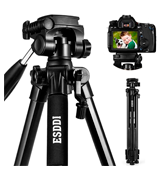
TACKLIFE 54-inch
Reliability Is the Key
TACKLIFE is a company that is mostly known for its high-quality power tools that usually beat the competition when it comes to reliability and longevity of their service life and less so for other equipment. That said, today we will take a look at something that is not an electric device - a camera tripod. Without further ado, let’s figure out - will it live up to the high standard of its manufacturer or not?
First of all, this 54-inch model is made of top-notch aluminium alloy, which makes it extremely light. Weighing only 0.6 kg, the tripod can handle a whopping 3 kg without breaking a sweat and that characteristic alone makes it a valid choice for small and medium-sized digital cameras with big lenses.
On top of the standard panoramic ball head that can turn 360°, the package features an additional tripod head that can hold modern gadgets like phones. Just like other similar tripods, though, this camera stand features non-slip feet on its legs that allow setting it up on harsh and uneven terrain with relative ease.
All things considered, if you are looking for a simple camera stand that can hold most point and DSLR camera models, this model will be right up your alley. It has a minimalistic design to it, which combined with durable retractable legs make it one of the top picks among other camera tripods.
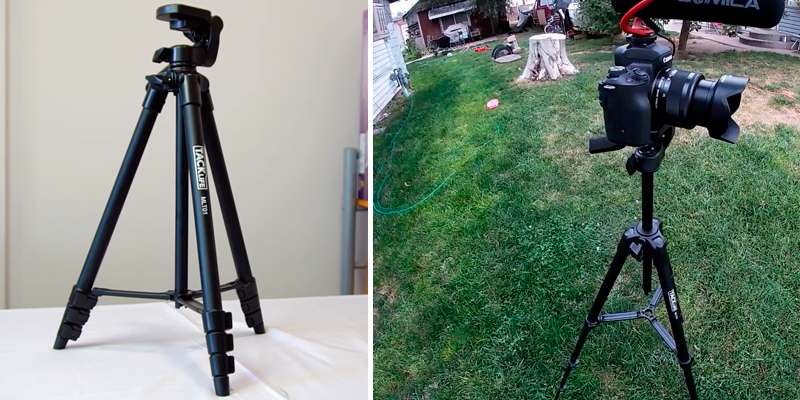
| Last updated price | £23.99 |
| Stock | May be out of stock |
| ASIN | B07BWK7Z7C |
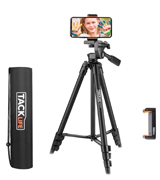
EVERESTA (TP-2141)
Light but Tough
This rather small tripod from EVERESTA is, perhaps, one of the lightest of the bunch included on our list. With an overall weight that barely reaches 0.4 kg, the camera holder can be used to secure cameras that weigh up to 2 kg, which includes both newer digital appliances and older film cameras.
Contrary to a plethora of other products for handheld cameras, the EVERESTA TP-2141 has means of remote control, thanks to a built-in Bluetooth module. To be more specific, the remote shutter can be paired with any Bluetooth-capable device, be it your iPhone or Android phone. Likewise, you can pair the shutter with cameras that have Bluetooth on board. Although the shutter requires a CR2 battery in order to run, it is included in the package, so you won’t have to buy one separately.
Moving on, the multi-angle ball joint enables rotating DSLR, point, and other cameras in virtually any direction. The handle on the side makes the process of finding the best possible angle even simpler, thanks to the smooth action and reliable joints that connect the camera to the tripod head.
When it comes to the legs of the tripod, they can be extended from the base 35 cm all the way up to 102 cm in a matter of seconds. For added convenience, the legs are equipped with non-slip feet, while the whole kit can be put inside a handy carry case that comes together with the hardware. Finally, this lightweight model will be a real find for amateur and semi-professional photographers that need an affordable stabilization tool for their phone and regular cameras.
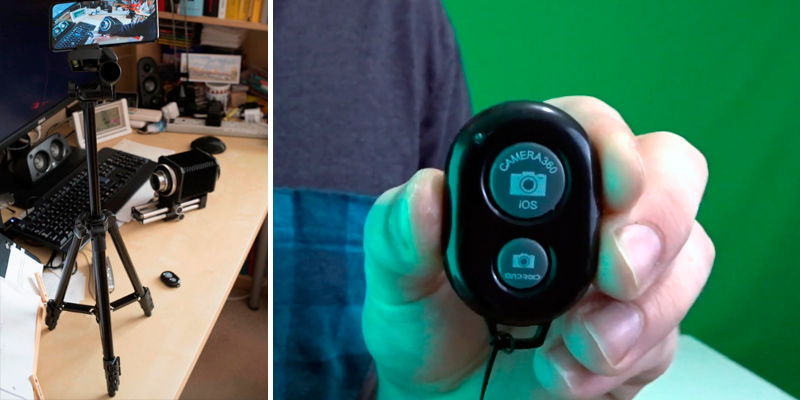
| Last updated price | £16.99 |
| Stock | In stock |
| ASIN | B0725GDDQX |
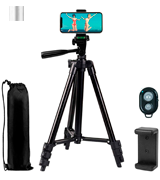
Hama Star 75
An Essential Stabilization Tool
The Hama Star 75 is another aluminium-based tripod that combines a lightweight build, minimalistic functional design that simply works.
The thing that separates this camera stand from the majority of similar products is a crank that makes it easy to adjust the height of the mounted camera. While the lowest point that you can shoot from is 42.5 cm, you can gradually lift DSLR, phone or a point camera up to 125 cm. This, combined with a ball joint that can rotate 360°, makes shooting with the Star 75 tripod a real breeze and also provides for quick shots or continuous, uninterrupted videos in case you are using a video camera.
Furthermore, the tripod head features a quick-release plate that makes it easier to switch between different cameras or phones if there is such a need. Last but not least, the aluminium legs of the tripod are rather flexible when it comes to lifting the centre stand up and down that also adds to the overall ease of use of the product.
To sum things up, the Hama Star 75 is a durable, easy to use, and, more importantly, reliable little camera tripod without needless bells and whistles that will appeal to a broader audience of amateur photographers that require a simple stabilizer for their cameras.
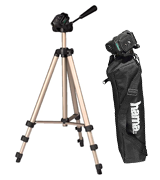
What Is a Camera Tripod?
Any photo enthusiast knows that frustrating feeling when a handheld photo just doesn't come out right because of the slightest vibration that smears the picture and totally ruins the effort. Therefore, photographers often use a special pole with 3 adjustable legs, called a tripod, to put their camera in a stable position and get a perfectly sharp shot, unaffected by trembling hands or vibrations from other sources. Any high-quality architecture masterpiece, nature, macro, and panoramic photographs are done with tripod support.
Furthermore, tripods are often used in photo studios for getting clear, crisp portraits of a sitter. However, you can also see them used for shooting news reports, documentaries, concerts, and movies. Usually, a tripod comes with a special camera head that mounts on top of the centre column. It provides better control of the camera movement flow and can be fixed in certain positions. But more of that below.
So, if you want to gear up your photo studio or you plan to set off for a long journey with a scenic route, you might also be interested in our review of the best camera backpacks with a strap for a tripod fixing. But that's not all. You might also want to check out our pick of the best portrait lenses. And for those, who want to know the latest tendencies in the photo industry, we can recommend our fresh selection of the best mirrorless cameras.
What Features to Compare
Let's say a few words about compatibility. Most camera tripods come with a column that has a 3/8" screw for mounting a head. The head, in turn, has a standard 1/4" screw that matches a threaded hole located at the bottom of most DSLR and compact cameras. Therefore, you can use your DSLR, GoPro or even TV camera with any of the tripods described in this review.
So, the first serious parameter to check out is the maximum Load a tripod can support. If you don't know the weight of your camera with a lens, just google them separately and sum up the weight. If you are worrying that a huge telephoto lens might disrupt the balance, look for a tripod with a counterweight hook at the bottom of the centre column. Also, some models come with a leg spreader that has bracket arms for some additional stability.
Check what material a camera tripod is made of. The most common materials used are carbon fibre and aluminium. The first one is lighter and somewhat better at vibration dampening, though such tripods cost more than the metal ones. A bit heavier aluminium model can be helpful for shooting outdoors where lighter models can be simply kicked over by the wind gust. But carrying a heavy model for several hours can be tiresome.
As a rule, tripod legs have from 2 up to 5 telescopic sections. The more sections, the more compact the tripod will be when folded. Still, a large number of parts may affect the overall stability of the stand. The centre column may also have 1 or 2 sections. There are a lot of models with telescopic legs and an adjustable centre column. Note that there are several head types that define the camera position and movement patterns.
- Ball head can be rotated all around and has a very smooth running, yet be careful not to bump it accidentally.
- 3-way Pan-Tilt heads are usually cheaper and allow a more precise adjusting. The downside is that they have large handles that always get in the way and also many levers that you have to tighten up or loosen almost every time to move and fix it in a certain position.
- Gimbal heads are very specific and designed for holding large and heavy cameras.
There are several features that can improve the usage of a tripod. For example, if the legs have pointy spikes on their ends, they will stand more securely on the soft ground. For shooting in a photo studio, you might need a taller tripod to take photos at the eye-level. The quick-release mount plate comes handy when you want to quickly change the cameras or when you need to take several handheld shots. By the way, some tripods can be transformed into a monopod that can provide some support for taking stable shots where you just can't unfold a tripod. Additionally, the package may also include some Extra Items like a pouch for the head or a carrying bag for the tripod itself.
Sources:
1. Simon Ringsmuth Tips for Choosing a Tripod Head, Digital Photography School.
2. Harry Guinness Everything You Need to Know About Choosing the Perfect Tripod, MakeUseOf. July 7, 2016.
3. How to Attach a Camera to a Tripod, wikiHow. August 2016.
4 Nasim Mansurov How to Use a Tripod, Photography Life. January 10, 2015.


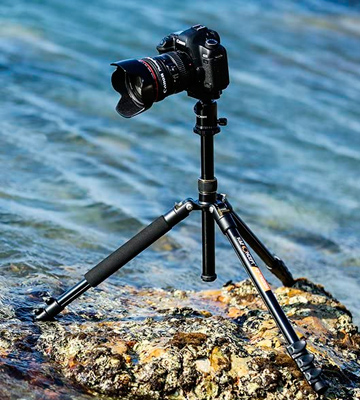
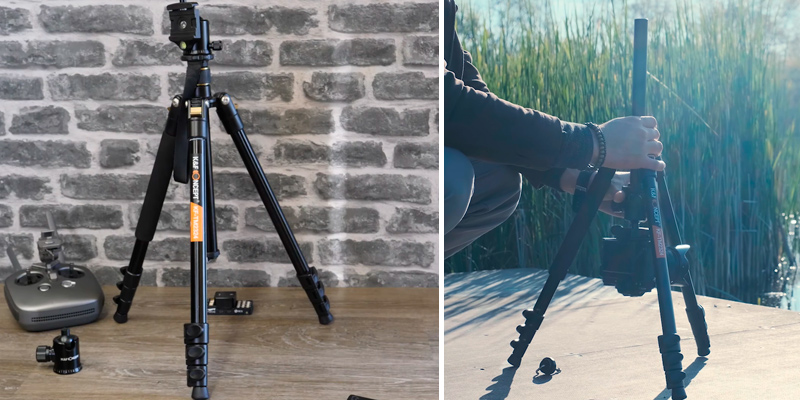
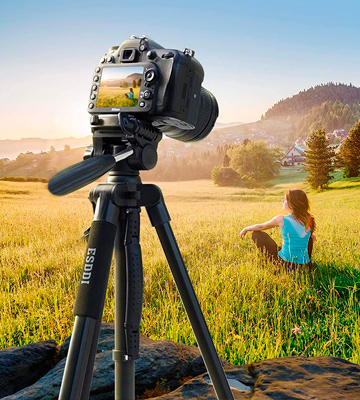
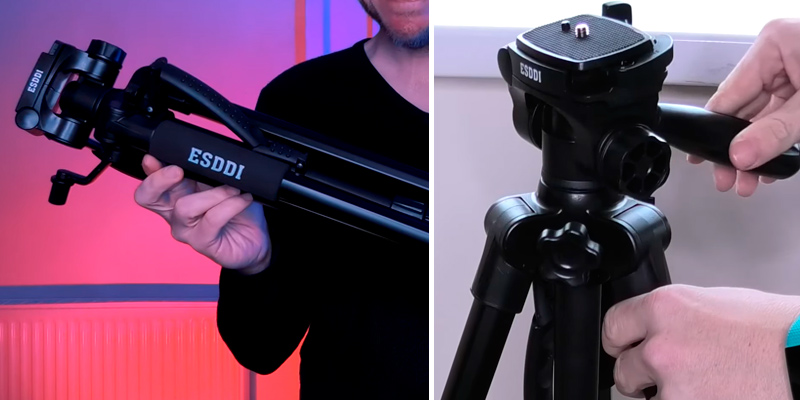
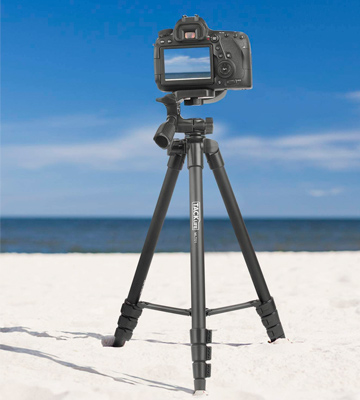
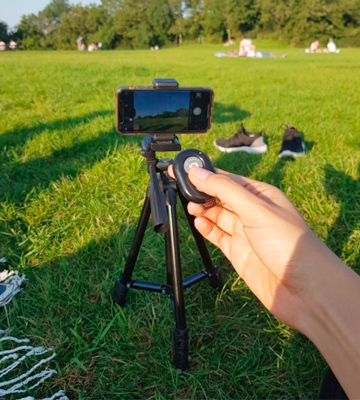
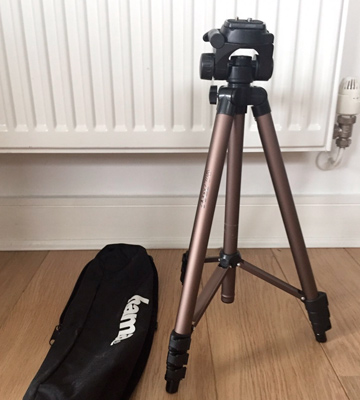
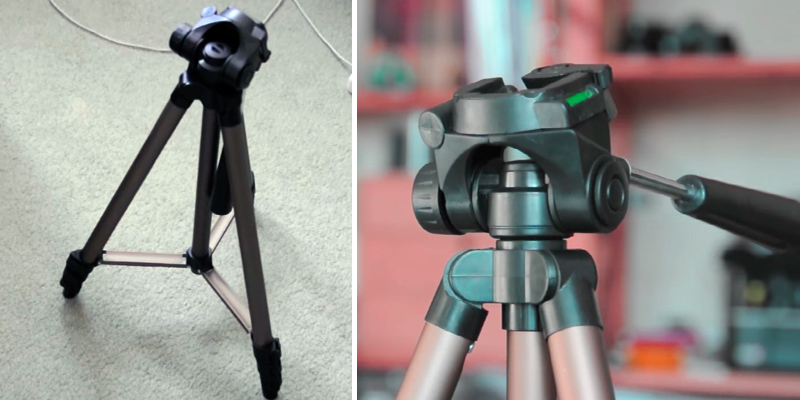

Your comment was successfully sent
Error! Please try again later